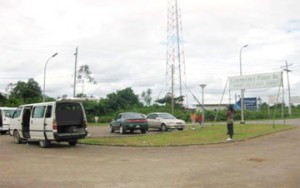– no real impact from Berbice bridge
Although the Moleson Creek Ferry Stelling experienced booming business for the Easter season the opening of the Berbice River Bridge did not have an impact on the number of vehicles crossing from Suriname to Guyana on normal days.

This newspaper was told by senior officers at the stelling that the MV Canawaima which has the capacity to accommodate 24 cars (or fewer cars along with large vehicles) had to make double trips for the Easter season.
This was necessary to clear the traffic on both sides of the river and the officers said that this was a “norm during the peak season” which started on Holy Thursday and ended on Wednesday. Only the first trip however was filled to capacity with about 200 passengers crossing per day during that time.
The ferry operates daily except on New Year’s Day, Good Friday, Christmas and Boxing Day. During the Christmas season and the August holiday there is some increase in the number of vehicles and passengers.
An average of 65 passengers cross on a daily basis but the officers noted that “many days only about 20 passengers and one vehicle would book to cross.” They also said that the Berbice River Bridge “has not heightened the crossing.”
When this newspaper visited the stelling on Thursday morning there was a long line of vehicles waiting to cross. Most of them bore foreign number plates, indicating that they were returning after visiting for the Easter season.
There were also several foot passengers, a few of whom were Guyanese living in Suriname and had “come home” to visit relatives for the holiday. They told this newspaper that they were “very excited” about the Berbice Bridge but said they did not have a reason to use it very
often.
A few other persons to whom this newspaper spoke said that they were traders and were going to purchase stocks for their “business.”
‘Backtrack’
crossing
Even after the river mishap in October last which claimed the lives of six persons when the propeller of a ‘backtrack’ boat got snagged in a fishing seine, many persons continue to use that service.
Two persons survived the tragedy; one was a worker on the boat, Leslie Austin, and the other was Sherry Haynes, a nurse in the United States of America. Austin swam about two-and-a-half miles until he landed safely on the shore of Number 63 Village.

Haynes who was wearing a lifejacket managed to stay afloat for 36 hours by clinging to an empty bucket. She was finally “washed” ashore at Number 57 Village.
A few days after the incident, passengers told Stabroek News, “we prefer to travel backtrack because we can go to Suriname and do our shopping and return the same day.” They said that the accident would not deter them from travelling in the speedboats which are licensed to carry eight passengers. The boats are equipped with lifejackets.
They said too that the ferry crossing was “too slow” and that the road from the ferry stelling on the Suriname side was “in a terrible condition.”
An elderly Suriname-based woman who was waiting at Moleson Creek to cross with the ferry on Thursday told this newspaper that “they [authorities in Suriname] are currently doing some work on the road.”
The woman who came to visit relatives on the Corentyne said she had not yet crossed the Berbice Bridge.
Charges
For a 21-day return ticket, adult passengers pay $3,000 (US$15) while the cost of tickets for children under 12 is $2,000. A 90-day ticket for an adult is $5,000 (US$25) and for children $3,000/US$15. Children under three are allowed to travel free.
For passengers to be eligible to travel via the ferry their passports must be valid for six months and the officers urge them to ensure that they check their documents properly before going to the stelling.
They said that the cost for cars which are categorized as ‘A’ class vehicles, for a 21 and 90-day period are $6,000/US$30 and $8,000 (US$40) respectively. For the ‘B’ class which includes pick-ups, 15-seater buses and RAV 4s weighing one to two tonnes, the cost is $8,000 (US$40) and $15,000 (US$75) respectively.
The officers said ‘C’ class vehicles which weigh two to three tonnes are charged $16,000 (US$80) and $20,000 (US$100), and ‘D’ class vehicles carrying a weight of 3 to 4.5 tonnes are charged $22,400 and $28,000 (US$140).
They said too that the charges for ‘E’ class vehicles weighing 4.6 to 6.5 tonnes are $28,000 and $33,600 (US$168), respectively, while vehicles in the ‘F’ class which weigh 6.6 to 8.5 tonnes pay $42,000 (US$210) and $49,000 (US$245).
They also told this newspaper that the ‘G’ class is the final category, and covers vehicles weighing 8.6 tonnes and over. In their case the charges for the 21 and 90-day periods are $70,000 (US$350) and $77,000 (US$385).
Motorcycles up to 500 cc pay $1,600 (US$8).
According to the officers the single price for the ‘A’ to ‘C’ categories is calculated by halving the 21 and 90 day charges, while in the case of the other categories the price for a single ticket is more than half of the return fare.
The ferry also accommodates cargo barrels and 20 and 40 ft containers.
The charge for a 20-ft container is $64,000 (US$329) and for a 40-ft one (they are not common) the cost is $104,000 (US$520). (Shabna Ullah)Captions:
1. A sign displaying ‘Canawaima Ferry Inc’ outside the Moleson Creek Ferry Stelling
2. A section of the Moleson Creek Ferry Stelling









